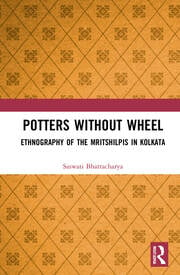
Saswati Bhattacharya’s book Potters without a Wheel: Ethnography of the Mritshilpis in Kolkata, published by Routledge in 2022, takes the reader on a journey of exploring the world of the clay-idol makers, the mritshilpis from Kumartuli, Kolkata. Structured across six chapters, the ethnography navigates various themes, ranging from concerns like the sociology of caste, economic sociology, sociology of aesthetics, and migration and questions around identity, gender, and political economy. Utilizing intensive fieldwork, in-depth interviews, and focus group discussions, the text provides a comprehensive account of the community.
The book begins by answering the primary question – why explore the genre of clay idol-making? The answer lies in the fact that this ethnography is intricately woven into the ontological, methodological, and disciplinary concerns of sociology. While delving meticulously into the lives of the idol makers, the text itself is skillfully embedded within the wider disciplinary conversations. Moreover, it is remarkable how the text sufficiently explains cultural elements for readers unfamiliar with Bengali traditions.
To further enhance the value of the text, various images are employed that engage readers, along with strategically interspersed case studies throughout the text. These individual narratives and pictures effectively humanize the wider analysis being conveyed, steering away from reducing people to mere statistical figures. Therefore, one can gauge a profound understanding of the nuances of people’s lived experiences.
When discussing a community engaged in a traditional occupation, it is critical to address caste. The second chapter effectively situates the conversation within the sociology of caste, tracing the unique trajectory of the Potter community. It emphasizes the dissonance between empirical reality and theoretical conceptualizations while examining the caste group’s contemporary manifestations.
Caste is a pertinent concern but the most significant analysis centers around the mritishilipis‘ market situation. In this context, the mritshilpis operate not just as artists but also as proficient traders. Their identity as craftsmen is illustrated through the emotional bond they share with their creations. Despite the necessity to prioritize rational action and profit the emotional energy expended in the process of creation remains paramount. Many artists point out how distressing it is to destroy their unsold creations in case the market factors negatively affect their sales (p.67). The impermanence of their art and thereby the fragility of their identity (which is closely associated with the art) is highlighted during Durga Puja, the anchor of their identity both as craftsmen and traders. The idol makers fade into invisibility once the Puja season is over.
This nucleus of their identity, Durga Puja, itself has undergone tremendous change. The changes in the external world are also reflected in the changing art world (Becker, 1982, p 309). What one witnesses are changing meanings of aesthetics and beauty influenced by a variety of factors. For instance, there has been a shift in demand for decorative pieces over time. With the emergence of thermocol and other plastic alternatives, the traditional Sola has been relegated to the sidelines due to the latter’s relatively high price. There are constant changes in how the Durga idol is decorated over time, resulting in the idol-makers having to innovate, renovate, and repackage based on consumer demands (p. 80). Overall, their identity as traders is illustrated through the ability to sustain their brand identity while simultaneously adapting to new demands.
Space is a central entity utilized to facilitate the analysis. It is not restricted to the physicality of the space, like added storage costs to meet the consumer demand, but also includes the description of the intangible spaces. Briefly mentioning the sociology of smell, Bhattacharya points out how she was “greeted by the familiar stench of clay, paint, fevicol, burnt plastic and urine” (p. 17) during her 2021 visit to the field. The description contains a variety of implications, most evidently the relatively static living conditions. There is dismal improvement observed in the lives of the mritshilpis despite multiple alleged attempts by various parties. While the mritshilpis are compelled to change and adopt new strategies to sustain their traditional art, very little positive change is witnessed in their personal space.
Nonetheless, the community has creatively capitalized on their “inability to succeed as businessmen” (p.58) because they are primarily artists. The selling point of these idols revolves around the authenticity associated with mritshilpis’ traditional caste identity and their creative culture. One can argue that this authentication is “not the province of experts and esoteric criteria but of popular and public kinds of verification and confirmation” therefore shaped by the specific “cultural regime” (Appadurai, 1986, p. 62). What could have marginalized the community in the market becomes a strategic marketing tool, lending legitimacy to their art owing to the specificities of their identity given the socio-historical context. Dr. Bhattacharya’s analysis focuses on this aspect. Their tactics of negotiating space reveal their interactions with the market; their caste name, Pal, traditionally authenticates their work, and their occupation as artists underscores the creative energy invested in the process.
The book is a testimony to how one cannot simply sideline the actualities of people’s lived experiences. Moreover, it marks the contradictions and negotiations that define the mritshilpi identities. Overall Potters without a Wheel: Ethnography of the Mritishilpis in Kolkata is at its core an engrossing ethnography that not only reveals the intricacies of the mritshilpis’ lives but also illuminates broader sociological paradigms. It urges readers to reflect on the complex relationships between tradition, commerce, and identity in a world that is changing rapidly.
References:
Appadurai, A. (1986). The social life of things. In Cambridge University Press eBooks. (pp. 16-74)
Becker, H. (1982b). Art Worlds (1st ed.). University of California Press. (pp. 300-321)
***
Vanshika Yadav is a student at the Delhi School of Economics (DSE), University of Delhi pursuing a Master’s course in Sociology.
[…] post Potters Without a Wheel: Ethnography of the Mritishilpis in Kolkata by Saswati Bhattacharya: A Revie… appeared first on Doing […]
Yes